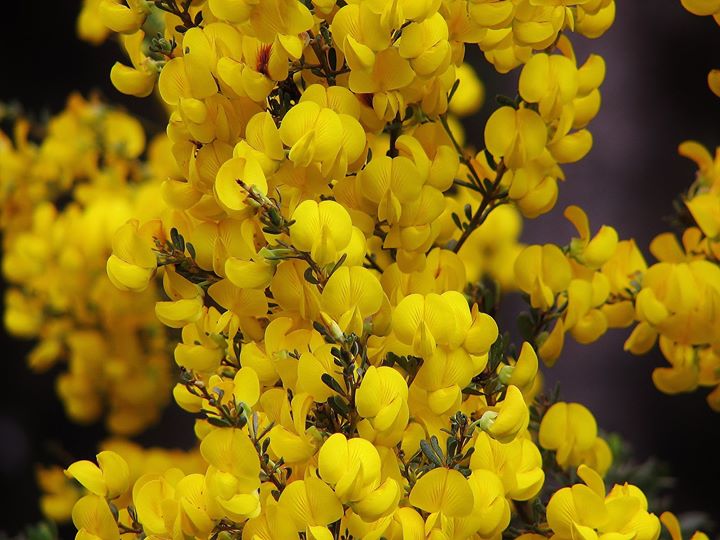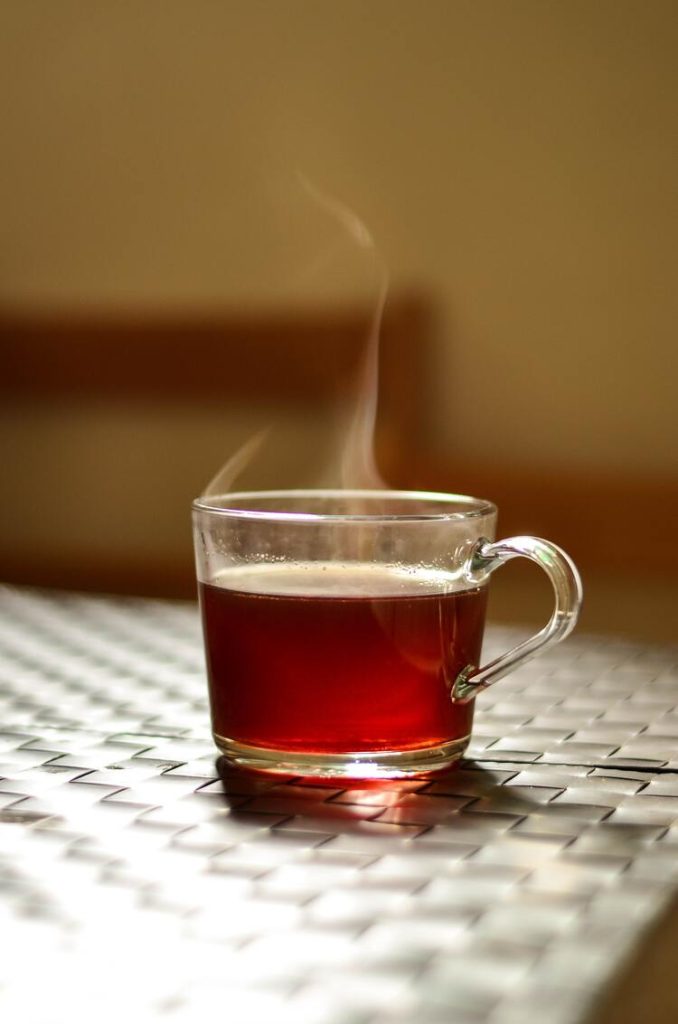What does honeybush tea taste like?
Honeybush tea is a caffeine-free herbal infusion made from the leaves of the Cyclopia plant. Its taste is characterized by a subtle sweetness that, as its name suggests, is reminiscent of honey. The flavor profile also boasts woody and earthy notes and slight hints of floral and fruity undertones. The tea’s warm, comforting aroma and well-rounded taste make it perfect for cozy evenings or as a soothing afternoon pick-me-up.
Keep reading to learn more about honeybush tea’s natural sweetness and fragrant goodness.
Please note: This article contains affiliate links, meaning I may earn a commission if you make a purchase by clicking a link. Of course, this comes at no extra cost to you and helps me keep offering readers solid information.

“Cyclopia subternata00” by Graeme Pienaar is licensed under CC BY-SA 3.0.
What is Honeybush?
Native to South Africa, honeybush tea comes from the Cyclopia plant. This plant grows wild in the Eastern and Western Cape regions of South Africa.
The name “honeybush” stems from the tea’s sweet and aromatic flavor, as well as the bushy appearance of the plant itself. You might be interested to know that there are over 20 species of the Cyclopia plant, each providing a unique taste and scent.
When harvesting honeybush, the process is very detailed. Stems, leaves, and flowers are all collected to create a well-rounded flavor. These parts are then bruised, allowing the enzymes within the plant to react and create that sweet aroma we all know and love.
The last step involves leaving the bruised plant material to oxidize and dry in the sun, ultimately turning it into a pleasant, amber-colored tea ready to be enjoyed!
What Does Honeybush Tea Taste Like?
Honeybush tea offers a delightful taste that you’ll surely enjoy. You’ll first notice its natural, gentle sweetness, making it a perfect choice for those who prefer not to add sugar to their beverages.
You’ll also find a distinct honeymark flavor in this tea, which comes from the honeybush plant’s flowers that bear a sweet, honey-like scent. As you sip the tea, the floral undertones will become apparent, giving you a soothing experience reminiscent of a stroll through a bloomed garden.
Honeybush tea’s sweetness is not overwhelming to the palate. While the sweetness of this tea might not satisfy your sugar craving, it’s more than enough to create a captivating taste.
Many people love combining honeybush tea with other herbal teas, fruits, or spices to create a more delightful taste. These combinations complement each other, embracing the honeybush tea’s sweetness and the added flavors, resulting in a delicious harmony. Don’t worry; our recommendations section will provide plenty of blending/mixing ideas.

“Honeybushtea” by Badagnani is licensed under CC BY 3.0.
Harvesting and Fermentation
The harvesting and fermenting processes dramatically contribute to honeybush tea’s distinct taste. Let’s dive into these processes a bit more.
When it comes to harvesting honeybush tea, timing is everything. The tea is typically harvested in the wild from the Cyclopia intermedia species during the spring and summer months when the plants are in full bloom. This allows for the highest concentration of essential oils and flavor compounds in the leaves and flowers. The harvesting process is done by hand, ensuring careful selection of the most flavorful parts of the plant.
Once the honeybush has been harvested, it undergoes a natural fermentation process (similar to oxidation in black tea; we are not referring to the fermentation that occurs in beer and wine), which is crucial for developing its unique taste.
The harvested leaves and stems are placed in heaps and allowed to ferment for a specific period, usually a week or two. The fermentation process breaks down the plant material, releasing flavorful compounds and deepening the color of the tea leaves.
During fermentation, the temperature of the heaps is carefully monitored to ensure the process is going smoothly. Proper fermentation is essential as it helps to bring out honeybush tea’s sweet, fruity notes. Once the optimal level of fermentation is reached, the tea is spread out and allowed to dry naturally in the sun, locking in the delicious flavors and rich color.
Brewing Techniques
Brewing honeybush tea is simple, and you can easily do it at home. Here’s a friendly guide to help you make the perfect cup.
- Bring fresh, cold water to a rolling boil. It’s essential to use good-quality water to ensure a great-tasting cup. Remember, water temperature affects your tea’s flavor, so wait 30 seconds to let the water cool down slightly.
- Place a tea bag or loose honeybush tea leaves in your teacup. For a deliciously balanced flavor profile, use one tea bag or one teaspoon of loose leaves per 8 ounces of water. If you prefer iced tea, double the amount to maintain the full flavor after adding ice.
- Gently pour the hot water over your tea bag or leaves, making sure they are submerged. Steeping time will determine the strength of your honeybush tea. For a subtle taste, steep for 3 to 5 minutes. However, if you like your tea bolder, let it steep for 7 to 10 minutes. Remember that herbal teas, including honeybush, do not become bitter with longer steeping times.
- Once the steeping time has passed, remove the tea bag or strain the loose leaves. Your cup of honeybush tea is ready! Depending on your preference, you can customize your tea experience by adding sweeteners, milk, or lemon.
To prepare honeybush iced tea, follow the abovementioned brewing steps while doubling the tea. After steeping, remove the tea bag or strain the leaves. Let the tea cool down at room temperature, then pour it over a glass filled with ice.
Now that you know the brewing techniques, enjoy!

Food Pairings
Here are some food pairings that go well with honeybush tea (because it is more fun to pair tea with a bite, right?):
- Baked Goods: Honey muffins, scones, or honey-glazed biscuits. The tea’s natural sweetness complements these treats’ warm, buttery flavors.
- Cheese and Crackers: The tea’s mild sweetness helps balance the savory and salty notes of different cheeses, such as mild cheddar, gouda, or goat cheese.
- Fruit Salads: The tea’s delicate flavor harmonizes well with the natural sweetness of fruits like berries, peaches, or citrus. It’s a perfect choice for a light and healthy snack.
- Dark Chocolate: Indulge in a square of high-quality dark chocolate while sipping honeybush tea.
- Roasted Nuts: Enjoy honeybush tea with a handful of roasted nuts, such as almonds, cashews, or hazelnuts. The tea’s natural sweetness complements the nuts’ crunchy texture and earthy flavors.
- Spiced Desserts: Honeybush tea pairs well with spiced desserts like gingerbread, pumpkin pie, or cinnamon rolls.
- Grilled Meats: For a savory pairing, try honeybush tea with grilled meats like chicken, pork, or lamb. The tea can help balance the smoky and savory flavors of the meat.
- Mild Curries: The tea can be enjoyed alongside mild curries, such as coconut-based curries or vegetable stews. The tea’s sweetness and floral notes can complement the gentle spice profiles of these dishes.
Comparison with Rooibos Tea
You might notice similarities and differences in their taste profiles when comparing honeybush tea to rooibos tea. Both honeybush and rooibos teas are native to South Africa and are caffeine-free, making them popular alternatives to traditional tea varieties.
Honeybush tea has a naturally sweet, mildly floral taste, while rooibos tea, also known as red tea, is characterized by its slightly nutty and earthy flavor. The sweetness of honeybush tea can be delightful, especially if you’re looking for a tea that doesn’t require additional sweeteners.
Regarding tannin content, honeybush tea contains fewer tannins than rooibos tea. Tannins are naturally occurring compounds in various plant-based foods and beverages, including tea. They can give drinks a slightly bitter taste and may contribute to astringency or dry mouthfeel.
Here’s a quick comparison of the two teas:
| Tea Type | Taste | Tannin Content | Caffeine-Free? |
| Honeybush | Sweet, floral | Low | Yes |
| Rooibos (Red) | Nutty, earthy | Medium | Yes |
Though honeybush and rooibos teas share similarities, their flavors and characteristics may cater to different personal preferences. It’s worth trying both kinds to determine which one you enjoy the most.

“Cyclopia alpina 15170100” by Tony Rebelo is licensed under CC BY-SA 4.0.
Health Benefits
Honeybush tea comes with numerous health benefits!
Here are some key ones to keep in mind:
- Caffeine-free: Great for people who want to avoid caffeine, and perfect for enjoying any time of the day without impacting your sleep.
- Antioxidant-rich: Helps protect your body against oxidative stress and supports a healthy immune system.
- Iron and mineral content: Contributes to maintaining proper levels of essential nutrients.
Nutritional Content
You’ll find calcium, zinc, potassium, magnesium, manganese, and other trace minerals in each cup of honeybush tea.
Calcium is crucial for strong bones, teeth, and muscle function. Zinc plays a vital role in immune function, wound healing, and sense of taste and smell. Potassium is essential for maintaining proper fluid balance, muscle function, and keeping your heart healthy.
Moreover, magnesium helps regulate diverse biochemical reactions in your body, and manganese supports bone health, metabolism, and antioxidant function. These minerals support your well-being while enjoying a tasty cup of honeybush tea.
In addition to minerals, honeybush tea also contains essential vitamins. While you drink, you’re nourishing your body with vital nutrients.
Potential Side Effects
While honeybush tea is generally considered safe, it’s important to be aware of potential side effects. With your best interest in mind, this section aims to inform you about some concerns about this tea.
- Some people have experienced mild allergic reactions to honeybush tea. If you notice symptoms such as itching, hives, or swelling after consuming the tea, it’s best to discontinue use and consult a healthcare professional.
- Also, honeybush tea might have mild estrogenic properties, meaning it could mimic the effects of the hormone estrogen in your body. If you have a hormone-sensitive condition, such as breast cancer or endometriosis, you should consider speaking with your doctor before including honeybush tea in your daily routine.
- Lastly, limited research suggests that excessive consumption of honeybush tea might lead to liver damage in some individuals. While it’s important to note that more research is needed, it’s advisable to consume honeybush tea in moderation and keep a close eye on any unusual symptoms.
As always, our advice is to start by consuming small quantities of any new herbal beverage and consult a doctor if you have any concerns or are taking any medication.

Buying Recommendations
If you are looking to try honeybush tea, here are our top recommendations:

Honeybush Tea 1LB (16Oz) 100% CERTIFIED Organic

Davidson’s Organics, South African Honeybush

The Coffee Bean & Tea Leaf African Sunrise Herbal Tea, Honeybush

Here are some honeybush blend recommendations:
Twinings Honeybush, Mandarin & Orange Herbal Tea

The Republic of Tea Organic Honeybush Vanilla Turmeric SuperDigest Tea

Frequently Asked Questions
Is honeybush tea sweet or bitter?
Honeybush tea has a naturally sweet taste with subtle hints of fruit and flowers. Although it’s not overly sweet, it lacks the astringent or bitter notes often found in other types of tea. This makes it a popular choice for those who don’t enjoy strong or bitter flavors in their tea.
How do honeybush and rooibos tea flavors compare?
Honeybush and rooibos teas are often compared due to their similar origins and appearance. However, their flavors are distinct. Rooibos tea is slightly nutty and earthy, while honeybush is sweeter, fruitier, and more floral. This difference in flavor makes honeybush the ideal option for those who prefer a gentler, sweeter taste.
What are typical flavor notes in honeybush tea?
Some of the most common include apricot, peach, honeysuckle, and floral undertones.
Is honeybush tea a good option for those who dislike strong flavors?
Absolutely! Honeybush tea is a fantastic choice for those who don’t enjoy the strong tastes often found in traditional teas like black or green tea. Its mild sweetness, subtle fruity, and floral notes make it a pleasant, easy-to-drink option.
What ingredients complement honeybush tea?
There are many ways to enhance the flavor of honeybush tea. Some popular ingredients include lemon, honey, and mint. These additions not only enhance the flavor but also help to bring out its natural sweetness. Additionally, you can try blending honeybush with other mild herbal teas, such as chamomile or spearmint, for a unique and refreshing beverage.
Can you describe the taste and aroma of honeybush tea?
As you sip honeybush tea, you’ll experience a naturally sweet and fruity flavor with a hint of floral undertones. These flavors marry perfectly with the tea’s pleasant, soothing aroma, reminiscent of honey, apricots, and meadow flowers. This combination makes honeybush tea an inviting and enjoyable beverage, perfect for savoring any time of day.
I hope you have enjoyed the article!
To you, what does honeybush tea taste like?
More About Herbal Tea
What Does Peppermint Tea Taste Like?
What Does Mint Tea Taste Like?
What Does Ginger Tea Taste Like?
What Does Lemon Balm Tea Taste Like?
What Does Chamomile Tea Taste Like?
What Does Lavender Tea Taste Like?
What Does Mullein Tea Taste Like?
What Does Raspberry Leaf Tea Taste Like?